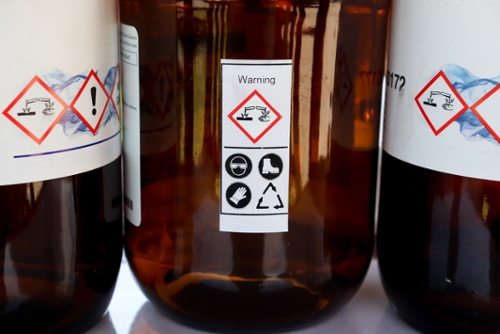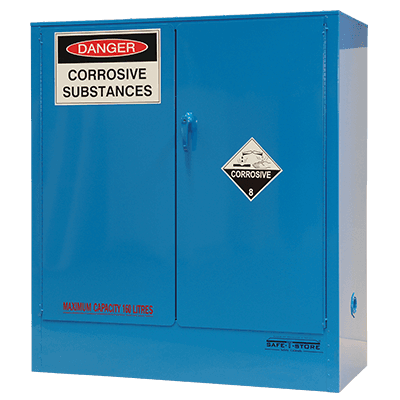To make sure the hazardous chemicals at your workplace are handled and stored correctly, it is essential to have a Chemical Management Procedure (CMP). Your CMP will include a full risk assessment of each substance as well as the development of suitable hazard control measures — like introducing a consistent chemical handling and storage procedure. This blog outlines the four steps involved in creating such a procedure.
1. Identify all the hazardous substances that are onsite
You cannot create a chemical handling and storage procedure until you know what substances are being used onsite, how they are being used, and where they are located. You first task is to identify every chemical at your workplace.
The first step in your process should be the correct identification of all chemicals.
The best way to do this is carrying out a full site inspection, walking around and physically identifying each substance. It’s a good idea to carry a sitemap or floor plan, marking the location of each chemical storage area.
An important part of the identification process is to obtain the Safety Data Sheet (SDS) from the manufacturer or supplier of each hazardous chemical. The SDS will specify the chemical hazards as well as handling, storage and emergency information.
2. Assess the risk associated with each chemical storage area
Once you have a list of the chemicals along with where they are located onsite, you can begin your risk assessment. You’ll want to look at the health hazards of each chemical (irritant, carcinogenic, poisonous) as well as the physiochemical hazards (explosive, flammable, corrosive).
Some questions you might ask during your risk assessment:
- Can untrained and unauthorised personnel access chemical stores?
- Are there hazardous chemicals which are incompatible with other substances and need to be stored separately?
- Are the flammable chemicals stored far enough away from ignitions sources?
- Are corrosives stored in a metal-free safety cabinet?
- Are chemical storage areas well ventilated?
TIP: to learn more about chemical hazards and how to control them read our blog Chemical Hazards in the Workplace.
3. Implement hazard control measures
Now it’s time to implement control measures to ideally eliminate or (at the very least) minimise each of risks associated with the chemical hazards. To comply with Australian WHS legislation you should use the Hierarchy of Control to do this.
To understand how the Hierarchy of Control works let’s imagine you use a hazardous chemical which is corrosive to metal, toxic and flammable. According to the Hierarchy of Control you should (in this order) try:
- Elimination. Could you stop using the corrosive substance completely?
- Substitution. Could you use a different chemical that is less harmful?
- Engineering. Could you store the corrosive substance in a safety cabinet in a NO SMOKING area away from ignition sources?
- Administration. Could you create safe handling and storage procedures?
- PPE. Could you have employees wear protective clothing and install safety showers and eye wash stations?
Your control measures might be a combination of items 3-5: storing the chemical into a corrosive cabinet, implementing a NO SMOKING policy at the workplace, and having employees wear chemical resistant gloves and eye guards.
Controls should include compliant storage suitable for the dangerous goods class of your substance.
Your chemical handling and storage policy will really be a documented summary of each of the control measures you introduce. And don’t forget that a major part of risk control is training your staff.
TIP: to learn more about controlling chemical hazards why not download our free eBook How to manage the risk of Hazardous Chemicals in the workplace.
4. Review your chemical handling and storage procedures
Once you’ve implemented all your control measures and trained all your staff, it’s important to sustain chemical safety at the workplace. You should have a system in place to ensure risk assessments are completed periodically — like when new chemicals are introduced to the workplace or the changes are made to job design.
Compliance with WHS laws is not something you can do once and then forget. Legislation changes, workplaces expand, chemical brands substituted, different work methods introduced, new staff hired.
Please make sure your chemical handling and storage procedure is updated regularly and always addresses the hazardous chemicals currently in use at the worksite.
Safer chemical storage and handling
Now you have an understanding of how to introduce a chemical handling and storage procedure into your workplace, we encourage you to take the next step. Download our free eBook How to manage the risk of Hazardous Chemicals in the workplace and learn exactly how to create and implement a full Chemical Management Program and get your workplace 100% compliant. Read it today.
Joining the team as a Dangerous Goods Storage Consultant, Melissa Hampton became Storemasta's Marketing Manager in late 2021. With extensive knowledge and experience in chemical compliance, Melissa is responsible for leading the Marketing team and helping shape their marketing strategy. In her spare time, you can find Melissa hiking, swimming and enjoying the great outdoors in beautiful north-west Tasmania.


